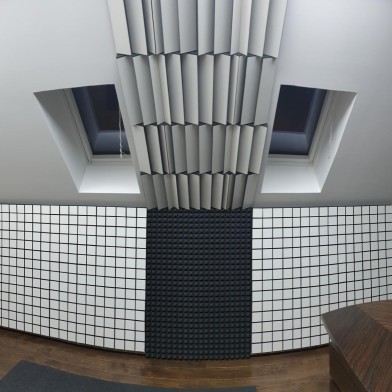How to remove echo and hum in the room?
- 24 July 2019 19:41:45
- Reviews: 0
- Views: 21357
-

Remove echo in the room - task number 1 when carrying out acoustic correction of the room
When faced with the need to improve the sound quality of a room, the first thing to pay attention to is echo (reverberation), as it is most noticeable.
In order to remove the echo during sound insulation and acoustic correction, various acoustic panels made of sound-absorbing materials are used.
Due to its structure, acoustic foam rubber is most often used as an absorbing material.
The force of the sound wave that enters it is amortized and converted into heat.
As a rule, such panels have a relief surface, which allows you to reflect the residual wave at an angle other than a straight one, which in turn allows you to distribute sound reflections in different parts of the panel in different directions, which allows you to remove the echo
After removing the echo, do not forget to remove the rumble
Removing echo in a room is undoubtedly a very important part of the process of acoustic correction and noise isolation, but in rooms with parallel walls, you should also pay attention to the effect of standing waves, which in everyday life has a more common name - hum.
This effect is created by repeated reflection of the sound wave from parallel walls in phase and its frequency depends on the distance between the walls.
For example, as a result, we hear either too much bass or too little.
Due to the fact that the intensity of some frequencies increases many times, we hear how our sound sources, monitors whistle or hum, which in turn affects the final sound quality.
The main consequences of standing waves are:
- at some frequencies their level rises;
- at the same frequencies, the duration of the sound increases - resonance;
- you can get dips at other frequencies.
How to avoid room hum
In order to avoid this effect, the rooms are designed with irregular shapes, for example, they put the walls at an angle other than a straight one or give them a curly shape.
Due to this, a uniform (diffuse) acoustic field is formed.
In this uniform acoustic field, the frequency response is determined only by the frequency dependence of the reverberation time and the sound source.
In most cases, the premises have rectangular walls and it is quite expensive to make them of a different shape, both in terms of costs and a reduced area of the room.
NOISE ISOLATION OF A ROOM USING ACOUSTIC DIFFUSERS.
A good solution to this problem is the use of acoustic diffusers.
They are designed to dissipate the sound wave incident on it, and not to reduce reverberation time, like most acoustic elements.
We produce acoustic diffusers from acoustic foam, wood and other rigid materials.
Their surface is not evenly shaped with a high reflection coefficient.
Acoustic pindiff panels help reduce echo and hum.
We also produce PinDiff acoustic panels, which are an effective solution both in the fight against the effect of standing waves and allow you to well remove the echo.
This is a great compromise between acoustic panel models that can only absorb the reverb effect and dissipate the standing wave effect.
The PinDiff model is made of high-stiffness acoustic foam, which is an excellent sound-absorbing material, which is covered with MDF.
This model has a fairly high level of sound absorption at low frequencies and a large sound dispersion coefficient at medium and high frequencies, which in turn allows you to soundproof the room from acoustic defects that appear as a result of reverberation effects and standing waves.
Due to the high level of sound absorption at low frequencies, it is possible to correct the frequency dependence of the reverberation time close to ideal. Rigid edges allow sound energy to be dissipated at early reflection areas.
In order to effectively remove echo and hum, it is better to place PinDiff acoustic panels in areas of high acoustic pressure.
Bass traps are a necessary element in order to remove the rumble.
As an addition to acoustic panels and acoustic diffusers, when soundproofing and acoustic correction of rooms in which it is necessary to remove the hum, it is necessary to use bass traps.
Bass traps should be placed in the corners because that's where bass energy accumulates.
Bass traps remove sound wave reflections between corners
The wider the bass trap, the lower the frequency level it can catch.
For best results, use a combination of the acoustic elements of the Saw bass trap with the Cube bass trap.
Application area
Most often faced with the need to remove echo and hum in these types of rooms:
- speech rooms;
- recording studios;
- rehearsal bases;
- cinemas;
- meeting rooms;
- office rooms;
- gyms;
- meeting rooms.
It is also appropriate to use these acoustic elements for soundproofing apartments, in which there is a large area of \u200b\u200brooms, in which there is not much furniture.
For example, if you need to remove the hum in the living room, home theater, home gym, then an effective solution would be to soundproof the room with PinDiff acoustic elements in combination with other acoustic panels.







